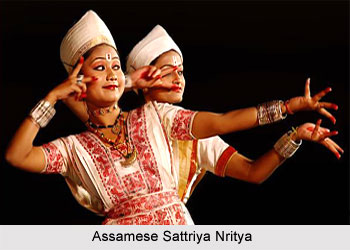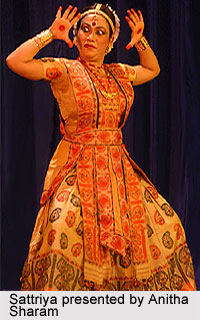 Sattriya or Sattriya Nritya, as it is also known as, happens to be one among eight main Indian classical dance traditions. Sattriya, since its creation in 15th century Assam by Vaishnav saint Srimanta Sankardeva, has remained a living tradition. The creation of Sattriya Nritya by Sankardeva was an accompaniment to the Ankiya Naat (a form of Assamese one-act plays devised by him), which were usually performed in the sattras, as Assam's monasteries are called.
Sattriya or Sattriya Nritya, as it is also known as, happens to be one among eight main Indian classical dance traditions. Sattriya, since its creation in 15th century Assam by Vaishnav saint Srimanta Sankardeva, has remained a living tradition. The creation of Sattriya Nritya by Sankardeva was an accompaniment to the Ankiya Naat (a form of Assamese one-act plays devised by him), which were usually performed in the sattras, as Assam's monasteries are called.With time as the convention grew and developed with the sattras, the dance form came to be called Sattriya Nritya.
History of Sattriya
Sattriya Nritya emerged from the sanctum in the second half of 19th century. This form of dance originated in monasteries and then moved to the metropolitan stage. There were tough austerities and discipline that were maintained by the Sattras within their limitations, until the first half of 19th century. This dance is performed with highly dedicated and ritualistic manner by male dancers alone. There are lot of factors (lack of research, rigid laws) that can be contributed to the delayed acceptance and recognition of Sattriya Nritya. One of the main advantages of adhering to the principles of the sattras has been its ability to maintain its pure form, and distinct style. As Sattriya has made its journey to the demotic spaces of the world's stages from the sanctified interiors of Assam's sattras, it is time for an improvement of Sattriya Nritya's aesthetic and artistic qualities.
This dance form received huge fame and name after Sangeet Natak Akademi recognized Sattriya as one of the classical dance forms of India.
Dance Style of Sattriya
 The main theme of Sattriya has had mythological connotation. This is an artistic and meticulous way of presenting teachings to the people in an immediate, accessible and enjoyable manner. Conventionally, this dance form was performed only by male monks (also known as Bhokots) in monasteries as part of their daily rituals or to mark special festivals. In the modern days, Sattriya is performed on stage by women and men, who are not members of sattras, on themes not merely mythological.
The main theme of Sattriya has had mythological connotation. This is an artistic and meticulous way of presenting teachings to the people in an immediate, accessible and enjoyable manner. Conventionally, this dance form was performed only by male monks (also known as Bhokots) in monasteries as part of their daily rituals or to mark special festivals. In the modern days, Sattriya is performed on stage by women and men, who are not members of sattras, on themes not merely mythological.Sattriya Nritya is divided into many genres: Apsara Nritya, Behar Nritya, Chali Nritya, Dasavatara Nritya, Manchok Nritya, Natua Nritya, Rasa Nritya, Rajaghariya Chali Nritya, Gosai Prabesh, Bar Prabesh, Gopi Prabesh, Jhumura, Nadu Bhangi, and Sutradhara, among others. Sattriya Nritya, just like seven other schools of Indian classical dance, incorporates the doctrine required of a classical dance form: the treatises of dance and dramaturgy, like Natya Shastra, Abhinaya Darpana, and Sangit Ratnakara; a distinctive repertoire (marg) and the aspects of nritta (pure dance), nritya (expressive dance), and natya (abhinaya).
Sattriya Nritya is performed with musical composition called borgeets (composed by Sankardeva among others) which are usually based on classical ragas. For tradition performance, the instruments that are used are khole (drums), taals (cymbals) and the flute. Some of the recent additions are the violin and the harmonium. The dress is typical of Assam as the silk that are worn are produced in Assam, woven with meticulous designs.
For more visit the link given below: